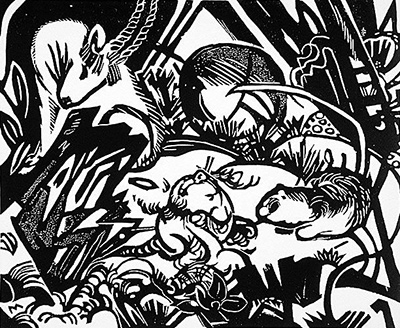This beautiful piece was created in 1912 as a woodcut. It was first displayed in an 1919 art review entitled Genius. The piece is in bold black and white and is a complex swirl of animal shapes, representing an idealised animal world of peace and harmony
As a piece that came into being in the increasingly tense period immediately preceding the horrors of the First World War- which was later to kill the artist- it is generally felt that this sense of tranquillity within the animal world is a deliberate contrast to the hostility and brutality of the human world of the time.
Within Marc's work animals were frequently held to represent both spirituality and a closeness to the natural world.
Franz Marc was an eminent member of the grouping of German Expressionists in the pre-War period who were radically changing the face of art in Europe. He worked in both woodcut and lithography, and had a strong "language" of colour throughout his work, using different hues to symbolise varying emotions: blue as spirituality, for example, or yellow to represent joy.
With this in mind the black and white of this piece is significant. It is reflected in his other works; Geburt der Wölfe,(Birth of the Wolves), Drei Tiere (Three Animals), and Pferd und Igel,(Horse and Hedgehog) which are all in a very similar style.
Marc died tragically in 1916 while waiting to be recalled from the front in a Government initiative to withdraw important artists for their own safety.
Some years later he was condemned by the Nazi party as a "degenerate" artist, but in subsequent years his importance has been recognised and his home in Berlin boasts a historical plaque. Some of his works can now command prices ranging in the millions of dollars.




